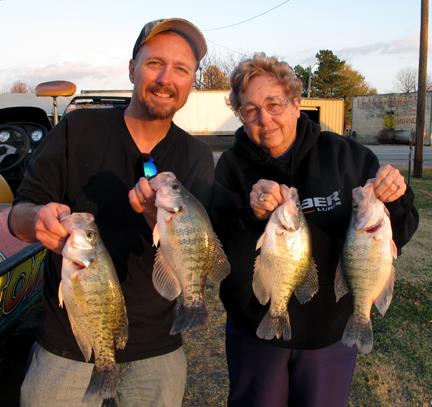 Everyone’s a crappie-fishing expert during the spawn, but it takes homework and time on the water to be successful year-round. Many anglers don’t have the time, however, to do all of the research and put in the time to be consistently successful , especially during winter. That’s when a good guide is worth his weight in gold, and we had one of the best in late December on a trip to Oklahoma’s Lake Eufaula with Todd Huckabee.
Everyone’s a crappie-fishing expert during the spawn, but it takes homework and time on the water to be successful year-round. Many anglers don’t have the time, however, to do all of the research and put in the time to be consistently successful , especially during winter. That’s when a good guide is worth his weight in gold, and we had one of the best in late December on a trip to Oklahoma’s Lake Eufaula with Todd Huckabee.

This giant body of water consistently produces the best crappie fishing in the state, both in size and numbers. After first fishing with Huckabee during the summer I learned that he doesn’t pay much attention to common knowledge – we were plucking crappie out of just 3 feet of water while air temperatures topped 95 degrees! I was excited to see how he approached cold-water crappie fishing.
“I go as far up a creek as possible,” he said as we motored down one of the lake’s many creek arms. “It needs to be a creek that is not silted in – when you look at a lake map you don’t want a creek w
ith a real wide mouth or one that’s a flowing river that silts in. I look for smaller creeks with a depth of at least 15 feet.”
When looking for fish, Huckabee watches for cover along the channel drop-off in the appropriate depth range and pays special mind to baitfish activity.
“I’ve said it a million times, but if you locate a bunch of baitfish, it’s not a guarantee that there will be crappie nearby – there probably is but they’re harder to catch,” he said. “But (and that’s a big ‘but’), you’re not going to find crappie that don’t have baitfish nearby.”
So while the presence of baitfish is essential to catching crappie, it’s not just a matter of “find the bait, find the fish.” Huckabee looks for cover in association with bends in the creek channel, points, structure irregularities and near the mouths of inflowing creeks.
During cold-water periods, his main technique is strolling with two 10-foot rods with two jig on each. He keeps the jigs within a foot of each other, and usually more like 6- to 8-inches apart. He’s moving, but at a snail’s pace. The only action he imparts to the jigs is a twitch every 15 seconds or so. The boat and waves produce all of the action he needs.
The reel is mostly just a line holder, as he pulls off the right amount of line – measured against the rod – then often uses the rig like an advanced cane pole – never reeling at all. Since the majority of his fishing is done with less than 12 feet of line out, he can just lift the fish out of the water and into the boat, unhook it and toss it in the livewell and immediately be back in the water at the right depth.
Depth is a major factor in crappie fishing, as we all know, and Huckabee has a hard and fast rule: “Eight to 11 feet,” he said. “That’s the starting depth no matter when or where I’m fishing. I remember being on a panel of crappie guides once at a fishing event and we got that question from someone in the crowd, and every other guide or pro fisherman in attendance nodded in agreement, so I guess it’s that way pretty much across the board.”
YUM Wooly Beavertail on a Lindy XChange Jighead. His most productive color patterns are black with a pink tail, black with a chartreuse tail and the same tail colors with a white body. The Wooly Beavertail has a ribbed body and a wide, quivering tail. He threads the bait on the jighead with the tail horizontal to provide plenty of fish-attracting vibration and movement.
“The most important color consideration is to simply have two contrasting colors – a stark difference between the head and tail. I think the fish zero in on the abrupt color change,” he said. “I always have more luck with a two-color bait over one that’s just a solid color.”
He subscribes to the “dark days/dark lures” theory when selecting jig colors and notes that wintertime itself suggests starting with a darker lure. With the sun at such an angle during winter it doesn’t penetrate the water as directly as during summer, and this combined with water color, wind and the presence of clouds factor into that decision. When fishing murky water on a cloudy, windy day, he’ll start with darker combinations like black/pink. Clearer days and water have him reaching for a white/chartreuse.
.
